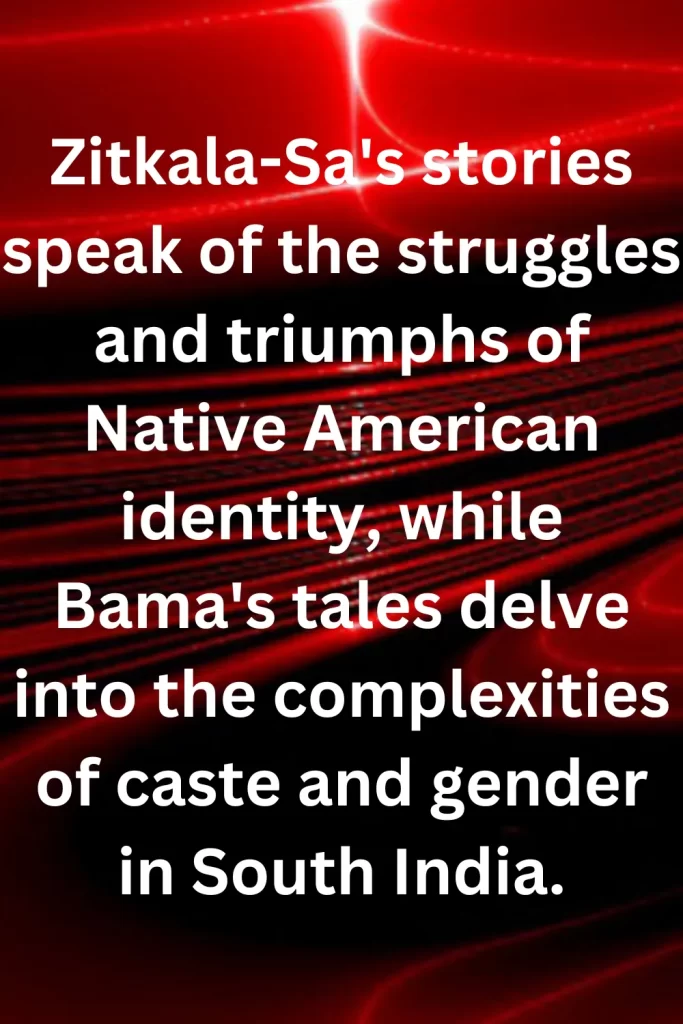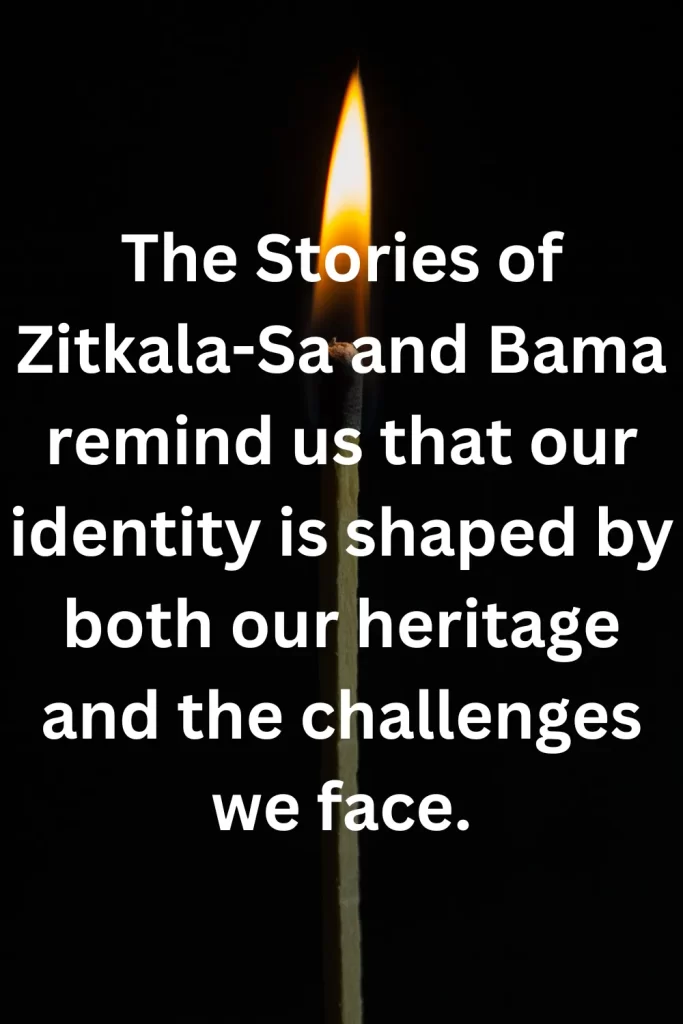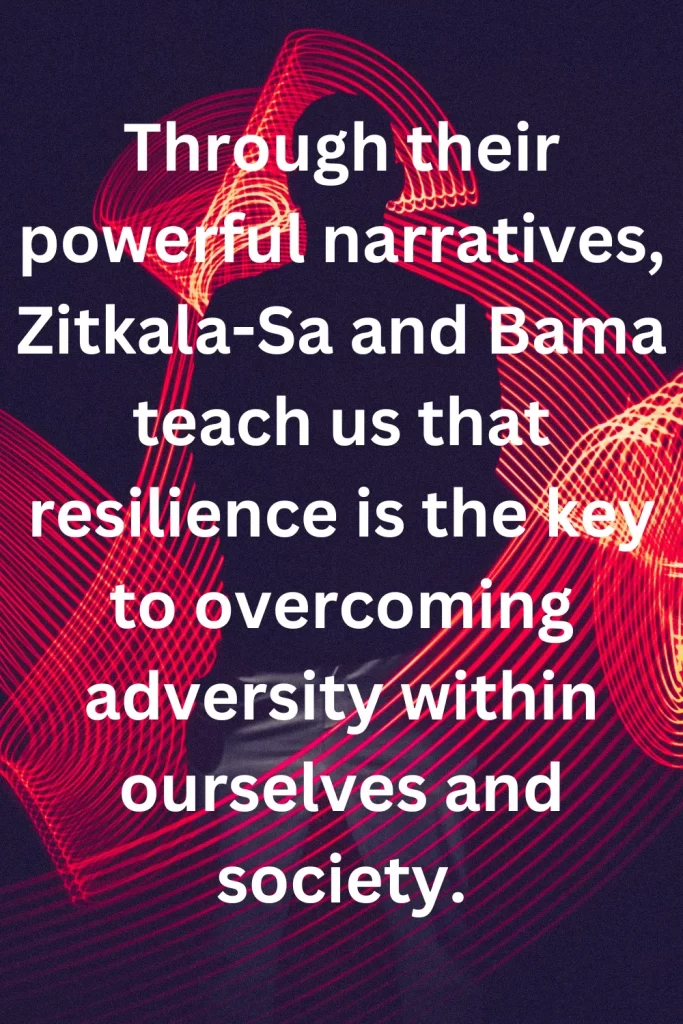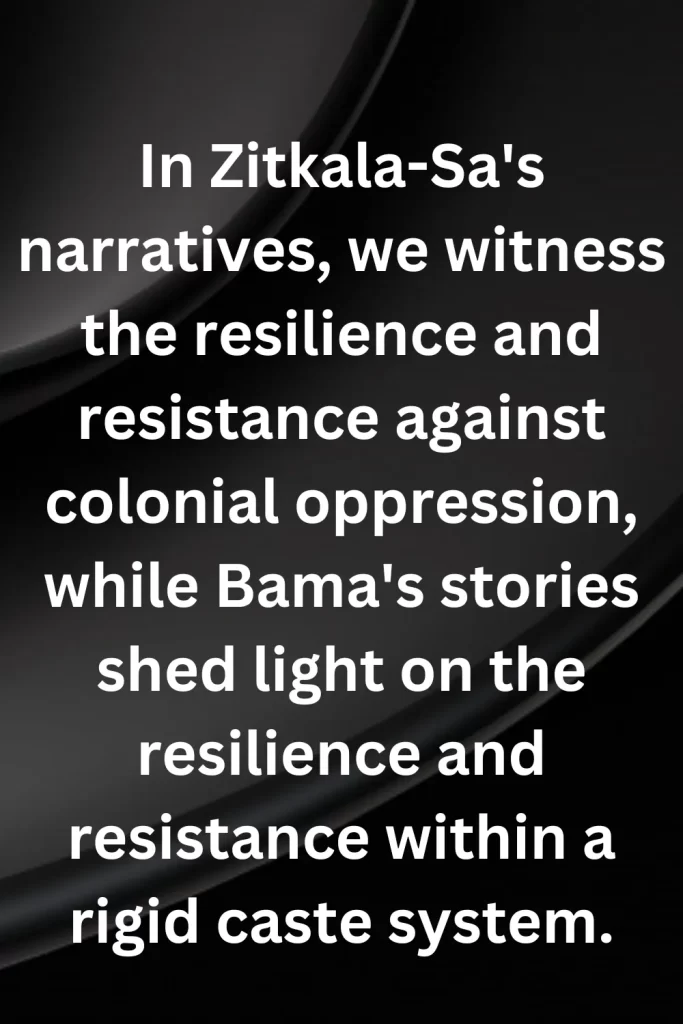Compare and contrast the powerful narratives of Zitkala-Sa and Bama, exploring the intersectionality of Native American and South Asian experiences.
Table of Contents
Imagine being torn between two worlds, caught in the crossfire of cultural identity and the desire for acceptance.
In a world that demands conformity, Zitkala-Sa and Bama dared to challenge societal expectations, their stories echoing with resilience and triumph. Zitkala-Sa, a Native American woman born into the Yankton Sioux tribe in the late 19th century, fought against forced assimilation and tirelessly championed indigenous rights.
Bama, on the other hand, grew up as an untouchable Dalit girl in rural Tamil Nadu, India, navigating caste-based discrimination with unwavering determination.
As we delve into their narratives side by side, we uncover two extraordinary journeys that intertwine at the core of human experience – advocating for justice and reclaiming one’s true self.

Introducing Zitkala-Sa and Bama’s Stories
Zitkala-Sa and Bama, two remarkable women from different backgrounds, have shared their powerful stories through literature.
Zitkala-Sa, born Gertrude Simmons Bonnin, was an influential Native American writer and activist who delved into the complexities of identity, culture, and assimilation in her autobiographical works.
On the other hand, Bama’s stories shed light on the social challenges faced by Dalits (formerly known as untouchables) in India.
Despite their unique cultural contexts, Zitkala-Sa and Bama both showcase a resilience rooted in their personal experiences.
Through introspection and reflection, they explore themes of discrimination, loss of cultural identity, and the struggle to find one’s place in society.
Their narratives captivate readers by highlighting the universal human desire for belonging while challenging societal norms that perpetuate injustice.
While Zitkala-Sa focuses on her upbringing in a Native American boarding school during a time of forced assimilation policies by the government, Bama vividly depicts life as a Dalit woman growing up amid caste-based oppression in rural South India.
Both authors confront these injustices head-on through their storytelling techniques – Zitkala-Sa employs vivid descriptions to convey emotion and create empathy among readers while Bama uses stark realism to expose harsh realities.
In comparing these two inspiring literary voices – Zitkala-Sa with her exploration of Native American history

Background:
Exploring the historical and cultural context of both authors
When comparing and contrasting the stories of Zitkala-Sa and Bama, it is essential to delve into the historical and cultural context in which both authors lived.
Zitkala-Sa, also known as Gertrude Bonnin, was a Sioux writer who experienced life on a reservation during a time when Native Americans were facing significant challenges due to colonization and forced assimilation policies.
This context deeply influenced her writing, particularly in stories like The School Days of an Indian Girl where she explores themes of identity crisis and the loss of traditional culture.
On the other hand, Bama’s story reflects a different historical context – that of Dalits or untouchables in South India.
Bama’s experiences growing up as an oppressed caste person significantly shaped her writing style and themes.
Her book Karukku provides a poignant portrayal of social inequalities, discrimination, and the struggle for dignity faced by Dalits during post-independence India.
The oppressive cultural practices prevalent at that time are vividly described through Bama’s personal experiences.
By exploring the historical and cultural contexts surrounding Zitkala-Sa and Bama, readers gain deeper insights into their stories’ impact on literature as well as their significance within the larger socio-political narratives they represent.
Both authors skillfully navigate complex issues related to identity, power imbalances, and societal injustices through their unique perspectives informed by their respective cultures’ struggles for liberation.
Understanding these contexts enhances our appreciation for each author’s contributions
Themes:
Identifying common themes in their narratives
In examining the narratives of Zitkala-Sa and Bama, it becomes clear that there are common themes intertwined in their stories.
Both authors explore the issues of identity, cultural assimilation, and the struggle for autonomy within oppressive systems.
Although separated by time, geography, and cultural background, Zitkala-Sa and Bama both grapple with the complexities of navigating their respective worlds while remaining true to their heritage.
One recurring theme in both narratives is the exploration of identity. Zitkala-Sa’s story revolves around her journey from being a young Native American girl to a student at a white boarding school.
She constantly questions her place in society as she tries to reconcile her Native American roots with the expectations imposed upon her by white society.
Similarly, Bama’s narrative unveils a young girl growing up in poverty-stricken rural India, struggling to find her own sense of self amidst societal expectations and caste discrimination.
Cultural assimilation is another central theme found in both narratives. Zitkala-Sa vividly recounts the traumatic experience of being forcibly stripped of her native language and customs at boarding school.
She is forced to conform to white cultural norms which deny her heritage and attempt to erase it altogether.
In Bama’s story, we witness a similar struggle as she faces pressure from dominant Hindu society to cast aside her Dalit identity and adopt Brahminical customs that perpetuate social hierarchy.
Despite these challenges, both Zitkala-Sa and Bama exhibit
Narrative Structure:
Analyzing the storytelling techniques used by Zitkala-Sa and Bama
Zitkala-Sa and Bama are two remarkable storytellers who share their unique experiences through their writings.
While both authors differ in terms of cultural background and timeframe, they employ similar storytelling techniques that captivate their audience.
One common technique utilized by both Zitkala-Sa and Bama is the use of vivid imagery.
Through descriptive language, both authors transport readers into their respective worlds, allowing them to experience the sights, sounds, and emotions first-hand.
For example, Zitkala-Sa’s description of a vast expanse of soft green turf in her story Impressions of an Indian Childhood sets a serene atmosphere that contrasts with the harsh realities she later reveals.
Similarly, Bama’s depiction of the pumping station near our house in her novel Karukku evokes a sense of nostalgia for simpler times.
Moreover, both Zitkala-Sa and Bama employ autobiographical elements in their storytelling.
By drawing from personal experiences, these authors bring authenticity to their narratives while shedding light on important social issues. Zitkala-Sa recounts her struggles as a Native American growing up in a white-dominated society, exposing the injustices faced by her community.
Likewise, Bama discusses the discrimination faced by oppressed castes in India through her own encounters with caste-based prejudice.
In conclusion, despite their differences in cultural background and time period, Zitkala-Sa and Bama employ similar storytelling techniques to engage
Characterization:
Comparing the main characters and their development
The main characters in Zitkala-Sa’s Impressions of an Indian Childhood and Bama’s Karukku both undergo significant development throughout their respective stories. Zitkala-Sa, as a young Native American girl, faces the challenges of assimilation into white American culture during her time at a residential boarding school. T
hrough her experiences, she develops a sense of awareness about the erosion of her Native identity and fights against it. On the other hand, Bama, a Dalit girl growing up in rural Tamil Nadu, battles against caste discrimination and social inequality.
Her journey towards self-discovery and empowerment showcases her transformation from a meek and submissive child to an assertive advocate for change.
While both Zitkala-Sa and Bama undergo personal transformations, their approaches to resistance differ significantly due to their differing cultural backgrounds.
Zitkala-Sa becomes actively involved in resisting assimilation by rebelling against the strict rules of the boarding school.
She asserts herself by questioning authority figures and refusing to conform to Western notions of beauty or behavior. In contrast, Bama’s resistance takes on a more subtle form through education and knowledge acquisition.
With access to books obtained through secret meetings with boys from higher castes, she uses literature as a means to broaden her understanding of social injustice and envision alternative possibilities for marginalized communities.
In conclusion, while both stories share overarching themes such as identity formation, resistance against oppression, and personal growth, they also showcase unique journeys

Social Commentary:
Examining how both stories address societal issues
Both stories, Zitkala-Sa’s “The School Days of an Indian Girl” and Bama’s “Karukku,” explore the theme of societal issues.
In “The School Days of an Indian Girl, Zitkala-Sa examines the impact of boarding schools on Native American children.
She sheds light on how these schools stripped away Native American cultural identity and forced assimilation upon the students.
Through her personal experience, she highlights the traumatic effects that this loss of cultural heritage has on individuals, as well as the collective impact on Native American communities.
Similarly, in “Karukku,” Bama also addresses societal issues by delving into the caste system in India.
She unveils the discrimination and oppression faced by Dalits (untouchables) within society.
Bama not only narrates her own experiences but also provides a larger perspective by discussing systemic injustices towards Dalits at various levels – be it education, employment, or social interactions.
By sharing her story courageously, she brings to light an often silenced issue and challenges readers to critically examine their own biases and privileges.
It is significant to note that while both stories focus on distinct societal issues – one addressing colonial assimilation while the other highlighting caste discrimination – they share a common message: the need for social justice and equality.
Both Zitkala-Sa and Bama expose deep-rooted prejudices embedded in society that perpetuate injustices against marginalized groups.
Their narratives serve as powerful reminders that addressing societal issues requires
Cultural Identity:
Discussing the portrayal of cultural identity in each story
In both Zitkala-Sa’s Impressions of an Indian Childhood and Bama’s Karukku, the authors explore the complex portrayal of cultural identity.
Zitkala-Sa, being a Native American woman, describes her struggle to reconcile her indigenous heritage with the white American culture she encounters at the Indian boarding school.
This clash is exemplified in her narrative when she refuses to have her hair forcefully cut off, an act that symbolizes cultural erasure.
Similarly, Bama’s memoir recounts her experiences as a Dalit girl in Tamil Nadu, India.
Her story unveils the discrimination and prejudice faced by members of lower castes and shows how her Dalit identity greatly influences how she perceives herself and others.
Through her vivid descriptions of caste-based discrimination within her society, Bama highlights the importance of not only embracing one’s own cultural identity but also eradicating social hierarchies that perpetuate marginalization.
Both Zitkala-Sa and Bama bring attention to the ways individuals grapple with their cultural identities within oppressive societal structures.
They shed light on the difficulties faced by marginalized communities as they navigate between tradition and assimilation, trying to find a balance that allows them to preserve their heritage while asserting their individuality.
These stories serve as powerful reminders that cultural identity should be celebrated rather than suppressed or undermined by dominant cultures – it is through honoring our unique backgrounds that we can promote a more inclusive society for all.

Conclusion:
Summarizing similarities, differences, and overall significance
In comparing Zitkala-Sa’s story with Bama’s, we can identify several striking similarities and differences that showcase the unique experiences of these two women.
Both narratives shed light on the struggles faced by marginalized individuals within their respective communities.
Zitkala-Sa, a Native American woman in the late 19th century, recounts her journey through assimilation schools and her eventual disillusionment with Western culture.
Similarly, Bama, an Indian Dalit woman in the mid-20th century, describes her life marked by caste discrimination and poverty.
While both Zitkala-Sa and Bama faced significant challenges due to their social status and identity, it is important to note their distinct cultural contexts and historical backgrounds.
While Zitkala-Sa experienced forced assimilation into Euro-American society through education systems crafted to eradicate native culture, Bama lived in a deeply stratified society where caste-based discrimination was pervasive and deeply entrenched.
These divergent settings contribute to differences in the methods employed by both authors to navigate their hardships.
The significance of these stories lies not only in their ability to expose various forms of oppression but also in the healing power they offer for those who have endured similar traumas.
By sharing their narratives, Zitkala-Sa and Bama provide voices for marginalized communities that have been historically silenced.
Their stories serve as testimonies of resilience and strength despite immense adversity.
Through the power of literature, these authors have managed to resonate with readers across time and space
Quotes of The Stories of Zitkala-Sa and Bama
“The Stories of Zitkala-Sa and Bama remind us that our identity is shaped by both our heritage and the challenges we face.”
“Through their powerful narratives, Zitkala-Sa and Bama teach us that resilience is the key to overcoming adversity within ourselves and society.”
“The stories of Zitkala-Sa and Bama inspire us to embrace our unique voices and perspectives, even in a world that may try to silence them.”
“In the Stories of Zitkala-Sa and Bama, we discover the strength of community and the importance of preserving cultural traditions in an ever-changing world.”

FAQs
Discover FAQs about Zitkala-Sa and Bama, including their lives, works, and legacies. Get answers to your burning questions in one convenient spot!
1. Who is Zitkala-Sa and Bama?
Zitkala-Sa was a Native American writer and activist, known for her works depicting the struggles of Native Americans in the late 19th and early 20th centuries. Bama, on the other hand, is a contemporary Indian author who writes about the experiences of marginalized communities in South India.
2. What are some common themes in their stories?
Both Zitkala-Sa and Bama explore themes of cultural identity, discrimination, and the impact of colonization on indigenous communities. They shed light on the challenges faced by their respective communities and highlight the importance of preserving cultural heritage.
3. How do Zitkala-Sa’s stories differ from Bama’s?
While both authors tackle similar themes, Zitkala-Sa’s stories focus on the experiences of Native Americans during a period of forced assimilation into white American culture. On the other hand, Bama’s stories reflect the struggles faced by Dalits (formerly known as untouchables) in India’s caste-based society.
4. Are their writing styles similar?
Zitkala-Sa employs vivid imagery and powerful metaphors to convey her message, while Bama’s writing style is characterized by its simplicity and directness. Despite these stylistic differences, both authors effectively communicate the emotions and hardships experienced by their characters.
5. Do they address gender issues in their stories?
Yes, both Zitkala-Sa and Bama touch upon gender issues in their narratives. Zitkala-Sa explores the intersectionality of being a Native American woman within a patriarchal society influenced by white culture. Meanwhile, Bama delves into the ways caste-based discrimination affects women in South India.
6. What impact did their stories have on society?
Zitkala-Sa’s writings served as an important platform for raising awareness about Native American rights and cultural preservation. Bama’s stories, on the other hand, shed light on the marginalized communities in India and sparked discussions about social inequality.
7. Are their stories based on personal experiences?
Yes, both Zitkala-Sa and Bama draw heavily from their own personal experiences when writing their stories. They provide firsthand accounts of the challenges and injustices faced by their communities.
8. Can I learn about different cultures through their stories?
Absolutely! Reading Zitkala-Sa and Bama allows readers to gain a deeper understanding of Native American culture as well as the struggles faced by Dalits in India. Their stories offer valuable insights into diverse cultural perspectives and promote empathy and cross-cultural understanding.

Pros and Cons
Pros:
1. Provides a deeper understanding of the experiences and challenges faced by Indigenous Americans and Indian Dalits.
2. Allows for a comparison of the cultural, social, and historical contexts in which Zitkala-Sa and Bama lived.
3. Highlights the resilience, strength, and determination exhibited by both women in overcoming adversity.
4. Offers insights into the impact of colonization, assimilation policies, and discrimination on marginalized communities.
5. Enables readers to appreciate the diversity within marginalized communities and recognize common struggles.
Cons:
1. May oversimplify complex issues faced by Indigenous Americans and Indian Dalits by focusing on only two individuals’ stories.
2. Could reinforce stereotypes or generalizations about these communities if not approached with nuance.
3. May cause discomfort or emotional distress for some readers due to depictions of trauma or discrimination experienced by Zitkala-Sa and Bama.
4. Limited representation: Only two perspectives are provided, potentially excluding other important voices from similar backgrounds.
5. Comparison may overlook unique aspects of each woman’s story, overshadowing their individual achievements or contributions










